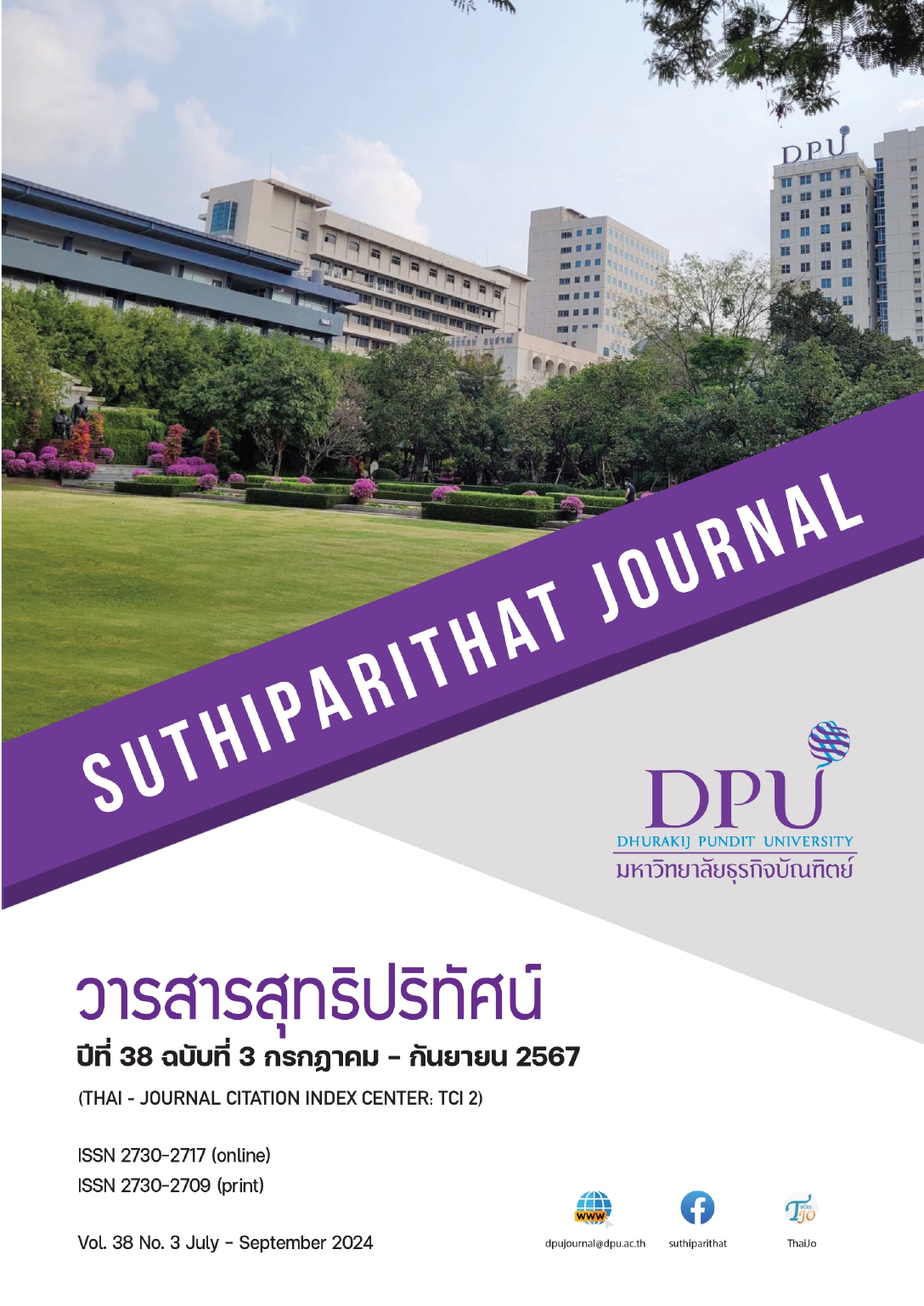ปัจจัยทางเศรษฐกิจที่กำหนดอาชญากรรมฟอกเงิน
คำสำคัญ:
การฟอกเงิน, อาชญากรรมฟอกเงิน, ปัจจัยทางเศรษฐกิจบทคัดย่อ
งานวิจัยในครั้งนี้มีวัตถุประสงค์เพื่อ ศึกษาปัจจัยทางเศรษฐกิจที่ส่งผลต่ออาชญากรรมฟอกเงินผ่านการรวบรวมข้อมูลแบบอนุกรมเวลา ได้แก่ จำนวนธุรกรรมที่สำนักงานป้องกันและปราบปรามการฟอกเงินดำเนินคดี จำนวนคดีอาญา จำนวนคดียาเสพติด อัตราเงินเฟ้อ GDP Growth จำนวนคนจน หนี้ครัวเรือน โดยทำการรวบรวมข้อมูลตั้งแต่ปี 2555-2564 นำมาวิเคราะห์ด้วยการประมาณค่าสมการถดถอยด้วยวิธีกำลังสองน้อยที่สุด ผลการวิจัยพบว่า ตัวแปรที่มีค่าสัมประสิทธิ์สหสัมพันธ์ถดถอยมากที่สุด 2 ลำดับแรก ได้แก่ ตัวแปรหนี้ครัวเรือนที่มีค่าสัมประสิทธ์เท่ากับ 3.749 และตัวแปรจำนวนคดีเสพติดที่มีค่าสัมประสิทธิ์เท่ากับ 3.532 งานวิจัยนี้มีข้อเสนอแนะให้รัฐบาลต้องมีนโยบายปราบปรามยาเสพติดให้เข้มข้นและจริงจังมากกว่านี้ ประกอบกับรัฐบาลดำเนินนโยบายทางเศรษฐกิจเพื่อลดจำนวนคนจนตลอดจนมีมาตรการดูแลประชาชนเรื่องภาระหนี้สินเพื่อลดจำนวนอาชญากรรมฟอกเงินให้มีจำนวนลดลง
เอกสารอ้างอิง
จำแลง กุลเจริญ. (2537). กฎหมายป้องกันการฟอกเงิน. ดุลพาห, 1(4), 19-20.
ทรรศนีย์ หลีชัยสถาพร. (2558). เศรษฐศาสตร์ว่าด้วยมาตรการต่อต้านการฟอกเงิน กรณีศึกษาการปฏิบัติตามมาตรการกำกับดูแลด้านการป้องกันการฟอกเงินและการต่อต้านการสนับสนุนทางการเงินแก่การก่อการร้าย [การค้นคว้าอิสระปริญญามหาบัณฑิต, มหาวิทยาลัยธรรมศาสตร์]. TU Digital Collections. https://digital.library.tu.ac.th/tu_dc/frontend/Info/item/dc:91593
ธนาคารแห่งประเทศไทย. (2564). เครื่องชี้เศรษฐกิจมหภาคของไทย 1. https://app.bot.or.th/BTWS_STAT/statistics/BOTWEBSTAT.aspx?reportID=409&language=TH
วิมุต วานิชเจริญธรรม. (2552). ดัชนีความทุกข์กับนโยบายการเงิน. วารสารเศรษฐศาสตร์ธรรมศาสตร์, 27(4), 34-80. https://so05.tci-thaijo.org/index.php/TER/article/view/137312
สำนักงานตำรวจแห่งชาติ. (2565). สถิติฐานความผิดคดีอาญา. https://data.go.th/dataset/rtp_crimes_stat
สำนักงานป้องกันและปราบปรามการฟอกเงิน. (2564). รายงานประจำปี สำนักงาน ปปง. https://www.amlo.go.th/index.php/th/strategy/annual-report
สำนักงานสถิติแห่งชาติ. (2564). สถิติรายได้และรายจ่ายของครัวเรือน. http://statbbi.nso.go.th/staticreport/page/sector/th/08.aspx
อรุณี ปัญญสวัสดิ์สุทธิ์. (2557). ปัจจัยที่กำหนดอาชญากรรมในประเทศไทย: การวิเคราะห์ข้อมูลพาแนล. ใน การประชุมทางวิชาการของมหาวิทยาลัยเกษตรศาสตร์ ครั้งที่ 52 สาขาศึกษาศาสตร์, สาขาเศรษฐศาสตร์และบริหารธุรกิจ, สาขามนุษยศาสตร์และสังคมศาสตร์ (น. 167-176). มหาวิทยาลัยเกษตรศาสตร์, สำนักงานคณะกรรมการการอุดมศึกษา;กระทรวงศึกษาธิการ, กระทรวงเกษตรและสหกรณ์, กระทรวงวิทยาศาสตร์และเทคโนโลยี, กระทรวงทรัพยากรธรรมชาติและสิ่งแวดล้อม, กระทรวงเทคโนโลยีสารสนเทศและการสื่อสาร, สำนักงานคณะกรรมการวิจัยแห่งชาติ สำนักงานกองทุนสนับสนุนการวิจัย.
Baath, D., & Zellhorn, F. (2016). How to combat money laundering in bitcoin?: An institutional and game theoretic approach to anti-money laundering prevention measures aimed at bitcoin [Master’s thesis, Linkopings Universitet]. Digitala Vetenskapliga Arkivet. https://www.diva-portal.org/smash/get/diva2:1039181/FULLTEXT01.pdf
Becker, G. S. (1968). Crime and punishment: An economic approach. Journal of Political Economy, 76(2), 169-217. http://dx.doi.org/10.1086/259394
Bhagwati, J., & Srinivasan, T. N. (2002). Trade and poverty in the poor countries. American Economic Review, 92(2), 180-183. http://dx.doi.org/10.1257/000282802320189212
Buchanan, B. (2004). Money laundering: A global obstacle. Research in International Business and Finance, 18(1), 115-127. http://dx.doi.org/10.1016/j.ribaf.2004.02.001
Financial Action Task Force. (2006). Trade-based money laundering, financial action task force, OECD. https://www.fatf-gafi.org/content/dam/fatf-gafi/reports/Trade%20Based%20Money%20Laundering.pdf.coredownload.pdf
Ghulam, Y., & Szalay, B. (2024). Investigating the determinants of money laundering risk. Journal of Money Laundering Control, 27(1), 139-157. https://doi.org/10.1108/JMLC-01-2023-0001
Hair, J. F., Anderson, R. E., Babin, B. J., & Black, W. C. (2010). Multivariate data analysis: A global perspective (Vol. 7). Pearson.
Khan, W. A., Jawaid, S. T., & Arif, I. (2018). Where does a nation’s wealth go? Evidence from a third world country. Journal of Money Laundering Control, 21(3), 426-476. https://doi.org/10.1108/JMLC-01-2017-0005
Mahmoud, O. L. (2015). The role of external debt on economic growth: Evidence from Mauritania. International Journal of Economics & Management Sciences, 4, Article 1000240.
Naik, P. A., & Tsai, C. L. (2001). Single‐index model selections. Biometrika, 88(3), 821-832. http://dx.doi.org/10.1093/biomet/88.3.821
Reganati, F., & Oliva, M. (2018). Determinants of money laundering: Evidence from Italian regions. Journal of Money Laundering Control, 21(3), 402-413. https://doi.org/10.1108/JMLC-09-2017-0052
Tiwari, M., Ferrill, J., & Allan, D. M. (2024). Trade-based money laundering: A systematic literature review. Journal of Accounting Literature. Advanced online publication. https://doi.org/10.1108/JAL-11-2022-0111
Vaithilingam, S., & Nair, M. (2007). Factors affecting money laundering: Lesson for developing countries. Journal of Money Laundering Control, 10(3), 352-366. https://doi.org/10.1108/13685200710763506
ดาวน์โหลด
เผยแพร่แล้ว
รูปแบบการอ้างอิง
ฉบับ
ประเภทบทความ
สัญญาอนุญาต
ลิขสิทธิ์ (c) 2024 มหาวิทยาลัยธุรกิจบัณฑิตย์

อนุญาตภายใต้เงื่อนไข Creative Commons Attribution-NonCommercial-NoDerivatives 4.0 International License.
เนื้อหาและข้อมูลในบทความที่ลงตีพิมพ์ในวารสารสุทธิปริทัศน์ ถือเป็นข้อคิดเห็นและความรับผิดชอบของผู้เขียนบทความโดยตรงซึ่งกองบรรณาธิการวารสาร ไม่จำเป็นต้องเห็นด้วย หรือร่วมรับผิดชอบใด ๆ
บทความ ข้อมูล เนื้อหา รูปภาพ ฯลฯ ที่ได้รับการตีพิมพ์ในวารสารสุทธิปริทัศน์ ถือเป็นลิขสิทธิ์ของวารสารสุทธิปริทัศน์หากบุคคลหรือหน่วยงานใดต้องการนำทั้งหมดหรือส่วนหนึ่งส่วนใดไปเผยแพร่ต่อหรือเพื่อกระทำการใด ๆ จะต้องได้รับอนุญาตเป็นลายลักษณ์อักษรจากวารสารสุทธิปริทัศน์ก่อนเท่านั้น







